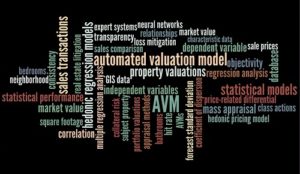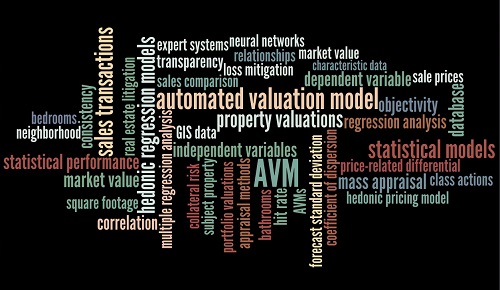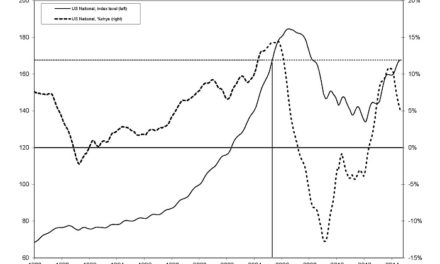An automated valuation model or AVM is a computer program that uses statistical models coupled with a database to estimate the market value of a property as of a specific date. The accuracy of an AVM depends on the data used and the skill of the modeler who produced the AVM. The basic logic of an AVM involves selecting a subject property, selecting a set of sales transactions, and using data about the sales transactions to estimate a value for the subject property. In other words, the relationship between the characteristics of the sales transactions (such as square footage) and their sale prices is used to calculate the value of the subject property. Thus, AVMs can function much like a traditional sales comparison analysis.
 However, in practice, AVMs are often much more complicated than that. Commercially available AVMs use different combinations of regression analysis, neural networks, expert systems, and other mass appraisal techniques. The process is typically carried out using hedonic regression models, a form of multiple regression analysis that has been used since the 1920s. The Uniform Standards of Professional Appraisal Practice (USPAP) defines a mass appraisal as “the process of valuing a universe of properties as of a given date using standard methodology, employing common data, and allowing for statistical testing.” Hedonic regression models are the most common technique for accomplishing mass appraisal.
However, in practice, AVMs are often much more complicated than that. Commercially available AVMs use different combinations of regression analysis, neural networks, expert systems, and other mass appraisal techniques. The process is typically carried out using hedonic regression models, a form of multiple regression analysis that has been used since the 1920s. The Uniform Standards of Professional Appraisal Practice (USPAP) defines a mass appraisal as “the process of valuing a universe of properties as of a given date using standard methodology, employing common data, and allowing for statistical testing.” Hedonic regression models are the most common technique for accomplishing mass appraisal.
Multiple regression analysis is a statistical method used to explore the relationships between several independent variables and a dependent variable. For example, a real estate agent might record for each sales transaction the square footage of the house, the number of bedrooms and bathrooms, the average income in the neighborhood, and a subjective rating of the appeal of the house (the independent variables). Once this information has been compiled for various houses, multiple regression analysis can be used to see whether and how these measures correlate to the sales price for a house (the dependent variable). For example, one might learn that the number of bathrooms is a better predictor of the sales price for which a house sells in a particular neighborhood than the subjective rating of “how pretty the house is.”
A multiple regression analysis applied to housing markets is often called a hedonic pricing model. In the case of complex goods such as houses or other real estate assets, economic theorists have shown that the prices buyers are willing to pay can be thought of as the sum of what they are willing to pay for particular property characteristics. These property attributes are called “hedonic characteristics” or variables.
Development of a database for an AVM involves gathering property characteristic data, sales transaction data, and geographic information systems (GIS) data. Any data source or combination of data sources that contain this information can be used in an AVM. The necessary data must exist in both sufficient quality and quantity for the AVM to show good statistical performance. An AVM can use hundreds or thousands of sales transaction records to estimate the market values of subject properties.
We hope that gives you a reasonable understanding of what an AVM is. Now, let’s talk about how they are used. A prediction of market value derived from an AVM is not considered an appraisal in and of itself. Put another way, an AVM value alone does not meet the USPAP definition of an appraisal; it must be used with the professional judgment of a skilled and experienced appraiser. However, if an AVM is properly developed and validated by an experienced and skilled appraiser, it can provide an objective and statistically accurate measure of property value. AVMs have been used to value residential property since the early 1990s. AVMs can be designed or adapted to accommodate different property types (e.g., single-family residences, condominiums, townhouses, and commercial properties), at different locations (e.g., regions of the country, regions within a state, and even individual neighborhoods), at different points in time (e.g., present or retrospective). The Appraisal Standards Board recognizes AVMs as an appropriate tool for performing appraisals when used competently by a trained and knowledgeable appraiser.
At first, AVMs were used primarily by institutional investors to evaluate collateral risk when purchasing mortgage loans. They are still used in that way, but AVMs are increasingly finding other uses in appraisal quality control, loss mitigation, portfolio valuations, insurance, and more.
Here at Greenfield Advisors, we have used AVMs for many years, often using various combinations of the methods described above to support our work in large-scale real estate litigation. Class actions or mass torts dealing with environmental contamination or other forms of real property impairment often require some method of valuing the properties. AVM valuations properly developed and validated by an experienced and skilled appraiser meet both the Frye and Daubert tests, and AVM valuations offer far more consistency, objectivity, and transparency across a large number of property valuations than individual appraisals. This consistency and objectivity are extremely desirable features of a valuation method; also desirable is transparency because it allows others to replicate our work.






Recent Comments